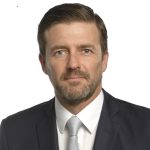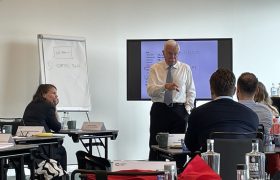The market for secondaries is growing

The outlook for secondaries – currently a 130 billion dollars a year market – looks very promising for the years to come. Limited Partners (LPs) globally are often overallocated to private equity, and some of them are seeking to offload their exposure by selling LP interests to secondary buyers. General Partners (GPs) of private equity firms are increasingly exploring GP-led secondaries to create liquidity for their investors since the conditions for other types of exits are not optimal. These GPs recognize the benefits of participating in the secondary market to generate liquidity or retain prized assets through so-called continuation funds. Three leading experts in this field take us through the ins and outs of this growingly important private market.
“The secondaries market should be up in 2024 for sure”, says Eric Deram: CEO of Flexstone Partners. Flexstone Partners is part of Natixis Investment Management, one of the mega asset management companies managing approximately 1.3 trillion dollars through various affiliates. Flexstone Partners is dedicated to private assets, managing over ten billion dollars. “We build and manage dedicated private assets portfolios for our clients, who are mostly institutional investors”, Deram explains.
The team comprises of sixty professionals across four offices (Geneva, Paris, New York and Singapore). The investment strategy is aimed at private equity funds, co-investment transactions, and secondaries. Secondaries allow LPs, like pension funds or family offices, to exit their private equity fund commitments with the approval of the GP. Originally, secondaries emerged as a strategy for LPs wanting to exit closed-ended funds. Over the past decade, the market evolved to include transactions at the underlying portfolio level, including GP-led transactions where GPs sell assets from their portfolios. This evolution has balanced risk diversification with targeted high-quality asset investments, enhancing returns.
Dr. Stephan Wessel is a Managing Partner of Montana Capital Partners. He elaborates that private equity secondaries form a niche within the expansive private markets, valued at a massive thirteen to fourteen trillion dollars in 2023, growing annually by ten to fifteen percent. “Despite secondaries currently representing just one/two percent of the private market, the secondaries market sees substantial annual transaction volumes of approximately 130 billion dollars”, says Wessel. “Traditionally, private equity funds had an average lifespan of thirteen to fifteen years, creating a need for secondaries to provide liquidity to LPs.”
“At Montana, we create a rewarding risk-return profile for our investors through a balanced mix of LP and GP-led transactions”, Wessel continues. “LP-led transactions are broadly diversified, spreading out risk, but they generally yield lower returns compared to direct investments in single companies. However, we now have the opportunity to invest specifically in certain assets, selecting and deselecting particular industries.”
The rise of GP-led secondaries: Unlocking liquidity and retaining value
One of the investors who is currently involved in the evolving market for GP-led secondaries is Evert Vink, partner at New 2ND Capital. Vink moved to New York in 2006 to work at AlpInvest which became part of the Carlyle Group in 2012. In 2021, Vink left for New 2ND Capital, which was founded in 2016 by three former colleagues from AlpInvest and Carlyle, including another Dutchman called Tjarko Hektor who had been the head of the secondaries team at AlpInvest.
New 2ND Capital is specialized in GP-led secondaries and focuses on the lower middle market and middle market in the United States exclusively. New 2ND Capital has historically had a preference to buy multiple portfolio companies simultaneously (multi-asset deals) for risk diversification and cash flow benefits, but it also does ‘single asset deals’. These portfolio companies are managed by the original private equity managers in continuation funds, with New 2ND Capital structuring the transaction, often becoming the largest LP in such continuation fund and providing the financing.
Vink highlights that continuation funds solve issues related to rigid structures of traditional private equity funds, offering flexibility and additional capital to ensure optimal exits for portfolio companies. “GP-led deals involve setting up a new fund to purchase one or multiple portfolio companies from an existing private equity firm, providing a solution for investors when companies need more time, additional capital for acquisitions, or new management”, Vink explains. “The acquired companies are placed in a new vehicle, managed by the original private equity managers, who continue to oversee the continuation fund. The legacy investors get two options. They can get their money from the sale of the portfolio companies to the new continuation fund, or they can choose to participate in the new fund under the same conditions as us. Unlike typical private equity funds that last more than ten years, continuation funds typically have a shorter term of four to five years, aiming to sell the portfolio companies within this period, allowing investors to see returns much sooner. As an aside, it is a misconception that a continuation fund is always available if a regular M&A exit for a company does not work out. Secondary managers like New 2ND are focused on good and promising assets: if a company does not sell in the M&A market, this does not automatically mean that a secondary deal is possible as a ‘second best alternative’. Often not.”

Name: Evert Vink
Company: New 2ND Capital
Head Office: New York
Strategy: New 2ND Capital invests in middle market companies through GP-led secondaries transactions in the US, including continuation funds, fund restructurings and spin-outs. The firm was founded in 2016 and is investing its third fund.
Markets: North America
Assets Under Management: over 1.8 billion dollars (per 31/12/2023)
Stephan Wessel also finds GP-led secondaries very attractive. “A manager with a portfolio of ten companies has already sourced and managed these companies for several years”, he explains. “By providing capital to an asset the manager already knows, you mitigate many information asymmetries. The manager will have worked with the company and its management team, often enhancing it, thus reducing several significant risk points. Aligning with the existing manager and providing further capital allows us to step into a situation that is already de-risked to some extent. The manager knows the company is solid and is willing to own the assets longer and invest more capital. To ensure alignment, we require managers to reinvest their carried interest into the Special Purpose Vehicle (SPV) and commit additional capital. We also use a tiered carry structure where the manager’s carry percentage increases with higher returns, demonstrating their confidence in the asset.”
Differences between US and European markets
As opposed to New 2ND Capital, Flexstone Partners and Montana Capital Partners are also active in Europe. Eric Deram from Flexstone highlights the size disparity, noting that over two-thirds of the global secondary market is in the US, which has greater transaction depth, sophistication, transparency, and intermediation. In contrast, Europe, which accounts for about thirty percent of the market, offers more direct negotiation opportunities with sellers. Deram: “In the US, many transactions – especially larger ones – are intermediated, and the best price usually wins, leading to what is known as the winner’s curse – you win the transaction but might have paid too much. In Europe more favourable pricing is often possible.”
Stephan Wessel adds that while the US market is dynamic and highly professionalized with specialized managers, Europe is fragmented with diverse languages and distinct markets. This fragmentation can be advantageous for secondary managers like Montana Capital Partners, who can exploit pricing inefficiencies. Wessel anticipates that Europe might offer more attractive exit opportunities in the next six to twelve months due to potentially lower interest rates and better credit and capital market conditions.
Addressing the complexities of operating in Europe, Wessel acknowledges the challenges posed by different legal systems, regulations, and tax codes. “For us as secondary managers, this fragmentation is advantageous because it allows us to exploit inefficiencies”, he says. “We have dedicated teams for each region and speak the necessary languages, which is beneficial since most secondary managers are based in the US and focus on the US market. While we are also overweight in the US due to its larger market size, our ability to pivot between Europe and North America based on where we see more relative value is valuable.”
Due diligence process & determining price
The three secondary investors each have a specific way of doing due diligence which is aligned with their overall investment strategy. “We have close relationships with around 300 fund managers who drive much of our deal flow”, says Eric Deram. “They often engage in quick, confidential transactions without broad auctions.” This is an effective way to compete for Flexstone Partners. “We know our portfolios well and can quickly assess the value of potential transactions. Due diligence involves fine-tuning projections for underlying companies and building DCF models for valuation. This deep knowledge allows us to act swiftly and effectively”, according to Deram.
Doing exclusively GP-led secondaries is a time-consuming activity for New 2ND Capital, Evert Vink comments. “These transactions typically taking six to nine months. We conduct due diligence at both the portfolio and GP levels. We review the portfolio companies and assess the GP’s ability to manage assets over the next three to five years and deliver good returns. We choose which assets to include based on different criteria. For example, we can exclude companies because we are not comfortable with their ESG profile, and we have done so in the past. This flexibility is a major advantage over LP deals, where buying a partnership interest involves accepting all associated rights and obligations.”
The due diligence process at Montana Capital Partners is very data driven, says Stephan Wessel. “All of our managing partners have a background in data. Our approach is rigorous. The founding team behind Montana structured the first securitization in global private equity with a sovereign wealth fund from Singapore. This complicated transaction required a model to price the underlying cash flows, and we use the same model today, though further developed and improved over ten years. It’s all about data, rigorous processes, diligence, and having teams on the ground on both sides of the Atlantic.”

Name: Stephan Wessel
Company: Montana Capital Partners
Head Office: Baar, Switzerland
Strategy: Montana Capital Partners (mcp) targets transactions at the smaller end of the mid-market. Mcp’s activities offer investors access to secondary investments which are below the radar of large secondary funds and which are therefore complimentary to large cap secondaries investors.
Markets: U.S. and Europe
Assets Under Management: 3.5 billion dollars
Decline in exit value creates momentum for secondaries
When asked about the key trends in the secondary markets for private equity, the experts highlight that over the past few years, LPs have faced liquidity issues due to low distributions from private funds. Another problem that many pension funds face is the ‘denominator effect’. This effect occurs when the valuation of public markets falls, causing the share of private equity in the total portfolio to rise relatively, prompting them to sell excess private equity assets.
On the GP side, raising funds has become challenging, with fund-raising durations extending to eighteen months or more. Additionally, interest rates were high, which made financing new deals more difficult. In the United States, bank failures in Silicon Valley in 2023 further increased banks’ fear of lending, further reducing liquidity and leading to fewer deals. Evert Vink adds that these elements have probably contributed to GP-led secondaries becoming a more and more popular solution for firms over the past few years.
Stephan Wessel adds that LPs rely on distributions from older funds to finance new investments, but 2022 and 2023 saw distributions fall well below expected levels. “From 2021 to 2023, the exit value fell by about sixty percent, and from 2022 to 2023, it fell by about forty percent”, he says. This decline in exit value has significantly impacted LPs’ ability to service capital calls, leading many to sell LP stakes in the secondary market. The difficulty in generating distributions and the challenges in raising new funds have created a liquidity-constrained environment, pushing more LPs to seek solutions through secondary transactions.
The increasing use of leverage in secondary deals is another trend, Deram observes. “I’m not so enthusiastic about innovations like debt financing and financial engineering, such as strip sales and NAV financing. These approaches increase leverage substantially in portfolios that are already highly leveraged, and they undermine a key advantage of private equity: the segregation of investments.”
Deram highlights that their strategy achieves comparable returns without leverage, avoiding the increased costs and risks associated with it, especially during economic downturns. Wessel acknowledges two types of leverage: fund-level, which they use for operational efficiency, and transactional, which Montana avoids in LP-led deals. All three experts agree that excessive leverage undermines the benefits of private equity by increasing overall risk and making returns more vulnerable to rising interest rates.
The impact of ESG
There has recently been a backlash against ESG especially in America, but at the same time institutional investors want to invest more in ESG funds. What is the vision of the experts on these contradicting developments? Eric Deram explains that ESG (Environmental, Social, and Governance) investing is becoming increasingly important in Europe, with a significant focus on decarbonization funds and Article 9 funds. Many institutional investors in Europe, especially in France, have legal obligations to invest in ESG-compliant funds. However, the US presents a contrasting scenario where some states prohibit investments in firms with ESG policies. Despite these challenges, Deram emphasizes the fundamental importance of ESG values and the potential for profitable and beneficial investments. His firm has maintained an ESG policy since 2005, reflecting their commitment to these principles. They ensure all investment opportunities meet ESG standards, and if an investment’s ESG score is too low, they do not proceed with it. Deram believes ESG is here to stay despite the varying global perspectives and political developments.
Stephan Wessel notes a similar divide in ESG emphasis between Europe and the US. In Europe, discussions about ESG are integral to investor meetings, with substantial time dedicated to it. European LPs, including large insurance companies and pension funds, are highly focused on ESG. Conversely, in the US, ESG is rarely mentioned in investor meetings. Wessel highlights the challenge of reporting ESG standards for older funds from vintages like 2013-2015, which were not initially designed with ESG considerations. Despite these hurdles, his firm strives to enhance their ESG approach and compliance, particularly for newer portfolios, indicating a continued commitment to ESG initiatives.
In Evert Vink’s experience, it all depends on which investor you speak with, also in the US. “We have US institutional investors who care very much about ESG and are very explicit in their expectations, just as much as some of our non-US investors. New 2ND Capital’s ESG policy has been in place for years. We diligence the companies we acquire, sometimes for months, and also on potential ESG concerns. If we are not comfortable with a company’s ESG profile, we exclude such company from the deal and do not look back.”
Expectation of secondaries market going forward
How do the three experts see the market for secondaries develop in the years to come Stephan Wessel emphasizes the concept of ‘capital overhang’, which refers to the surplus capital available for transactions. While the primary market has a high capital overhang due to reduced exit and buying activities, the secondary market’s capital overhang is lower at about 1.5 times, indicating a robust opportunity for investments.
“This imbalance, with abundant supply and constrained demand, allows secondary groups to be selective, potentially leading to better returns”, he explains. “Historically, returns have been around twenty percent, and the secondary market, currently representing only one percent of the private equity market, is expected to grow significantly. We believe the secondary market will grow from one/two percent to perhaps three, four or even five percent. Each percentage point increase adds about 100 to 120 billion dollars to the secondary market annually, creating a gigantic market ahead.”
Evert Vink discusses the role of the secondary market in providing liquidity solutions amid a challenging exit environment. He explains that if the exit market does not function properly, the secondary market offers a viable solution. “Continuation funds of GP-led secondaries will continue to exist”, he says. “Investors are now accepting this as an exit option and seeing that it can be beneficial for everyone involved. We believe the GP-led secondaries market in the US has matured and is definitely here to stay.”
Eric Deram provides a long-term bullish perspective on private equity and the secondary market. Despite current macroeconomic uncertainties and a challenging fundraising environment, he sees private equity as a growing asset class. He highlights that private equity provides capital to a significant portion of the real economy, making it an essential investment strategy. “The first private equity conference I attended was in ’94 or ’95 the title was: ‘Is there too much money chasing too few deals?’ This was in the mid-90s, and even then, people were saying private equity had become too big. Private equity has grown thirty times since then. And now, people are again saying there’s too much money in private equity. So, I often tell this story because people don’t realize the historical context.”
“Right now, the market is indeed a bit difficult”, Deram continues. “There’s a bit of indigestion and a lot of macroeconomic uncertainty. In Europe, the recent elections are not helping. The French stock exchange crashed recently, adding to the uncertainty. Higher interest rates, lack of distribution, and fewer transactions make it harder to raise funds. However, if we look at our portfolios of investments in Europe, they are performing reasonably well. For our fund of funds, co-investments, and secondaries, we track thousands of portfolio companies, and generally speaking, they are on budget for the next 24 months. 2023 was good, and most of our programs were up year-to-date and in 2023. So, in terms of valuation, I don’t see any catastrophe coming.”

Name: Eric Deram
Company: Flexstone Partners
Head Office: Geneva
Strategy: The investment strategy of Flexstone Partners is aimed at private equity funds, co-investment transactions, and secondaries. Flexstone Partners specializes in the small and lower mid-market, with investment sizes in private equity funds ranging from 200 million dollars to 1.5 billion dollars. Secondary transactions typically involve twenty to thirty million dollars.
Markets: 50/50 U.S. and Europe, with up to 5-10 percent in Asia
Assets Under Management: 10 billion dollars
Overall, Wessel, Vink, and Deram agree that while the secondary market faces challenges, its potential for growth, innovation, and providing essential liquidity solutions makes it a vital component of the private equity landscape.








